Jinsi Gorge Scenic Area
Jinsi Gorge Scenic Area of Shangluo City, Shaanxi Province, is located in the hinterland of Xinkailing in the southeast of Shangnan County, Shangluo City. It is 40 kilometers away from Shangnan County Town and 18 kilometers away from Jinsixia Town. There are five scenic spots, Bailong Gorge, Heilong Gorge, Qinglong Gorge, Shiyanzhai and Danjiangyuan. There are more than 100 scenic spots. The total length of the canyon is 20.5 kilometers and the depth is more than 10 kilometers. In October 2015, it was approved as a national AAAAA tourist attraction, as a national geological park, as a rare and most complete mountain valley geological structure in Qinling area.
In the 2008 Northwest China Tourism Marketing Conference and Tourism Equipment Exhibition, it was included in the "Magic Northwest 100 Sceneries" list.
History of scenic spots
On February 19, 2006, a team of 10 members from the State Scholars Resources Department of Shaanxi Province went deep into the Golden Silk Grand Canyon scenic spot for field geological investigation. Entering the scenic area, experts unexpectedly found many strange geological structures - Ma Luquan, Huang Longbu, Shishengshu, Lady Xiangua, Bajie Peep Bath, Prince Pool, Python Cave and dozens of other natural landscapes with geological characteristics.
On October 8, 2015, the website of the National Tourism Administration published a list of national 5A-level scenic spots, which included: Jinsi Gorge scenic spots in Shangluo City, Shaanxi Province.
On October 15, 2015, the website of the National Tourism Administration issued the Notice of the National Committee for the Quality Assessment of Tourism Resources Planning and Development. Jinsi Gorge Scenic Area in Shangluo City, Shaanxi Province, met the requirements of the national 5A-level tourist attractions standard and was approved as the national 5A-level tourist attractions.
April 13, 2018, was included in "Magic Northwest 100 Scenes".
geographical environment
position
Jinsi Gorge Scenic Area is located in Shangnan County in the southeast of Shaanxi Province, which is under the jurisdiction of Shangluo City. Located at the southern foot of Qinling Mountains connecting the northern slope of Bashan Mountains, it occupies the middle reaches of Danjiang River in the Hanjiang River system of the Yangtze River Basin. Danjiang enters Henan and Hubei from west to south. The Danjiang River in Shangnan County is divided into two parts: Danbei and Dannan. Danbei is the East extension of Mangling and Liuling. Dannan is located in the hinterland of Xinkailing, in which the Golden Silk Grand Canyon is located.
climatic conditions
The climate of Jinsi Grand Canyon is mild, and the natural climate belongs to the over-type of sub-tropical semi-humid monsoon climate to warm temperate semi-humid climate. The annual average temperature is 18 C, the summer average temperature is 22 C, the frost-free period is 217 days, the precipitation is 803 mm, the evaporation is small, and the four seasons are distinct. Apart from the colder winter, other times are more suitable for tourism.
The landform of Jinsi Gorge Scenic Area belongs to the mountain valley landform. There are many vertical and steep peaks, Valley walls straight up and down, the upper and lower deep canyons of equal width, the relative height difference between mountains and valleys can reach 200-300 meters; various caves, caves, there are a variety of stalactites, stalagmites, stalagmites, eels; many deep pools, narrow and long valleys, and thirteen-level stream waterfalls and other landscapes, which are rare and the most complete in Qinling area. The whole mountain valley geomorphology and geological structure is very rare in many national geoparks at present.
Main attractions
Bailongxia Scenic Area
Bailong Gorge, commonly known as Qili Gorge and North Gorge, is 2.5 kilometers long. From the north to Lingguan Hall, the canyon stretches in a hard "S" shape. The Canyon is high in the South and low in the north. There are abundant types of landforms in the canyon. Because of human activities, it is mostly a plant community. The main natural landscapes are river geological and geomorphic relics such as valleys and valleys, side-eroded caves and steep-wall water-fall, which are formed by river scouring, erosion and other geological processes. The mountain on the left side of the gorge mouth is called Fengshan, just like the Phoenix Spreading its wings; the mountain on the right is called Monkey Mountain, and there is a stone monkey on the top of the mountain, which is said by the immortal monkey to play phoenix. On the left side of the hillside, there is also a strange stone called Fairy Stone, also known as Fairy Peak. The rocky slopes and the upside-down vines make the natural scenery interesting and interesting. The rivers in the canyon are like white dragons winding north and south, and the dangerous peaks on both sides of the canyon rise and fall continuously.
Ma plane spring
Ma Luquan is one of the famous scenic spots of Bailong Gorge, also known as Baixuequan. This spring is a descending spring flowing out of the Cambrian dolomite strata more than 600 million years ago. Baixuequan is a natural mineral water, rich in calcium, iron, zinc, selenium and other trace elements needed by the human body. It is called "Shenquan" by the local people.
The formation of Ma'ao Spring is due to faults on the north side of the spring eye. Faults block the normal flow of underground karst spring water and form Baixuequan along a rock fracture to the surface. The spring is not cloudy, drought-prone, year-round, the average daily flow is about 0.39 cubic meters per second, flood season flow can reach 1 cubic meters per second. Spring eyes are as big as fists. There are countless small springs around the big springs. Spring water rushes up vertically one after another, spraying bubbles of one size after another. Every year in midsummer, the rainfall is abundant, springs gush out, the water column is more than 1 meter high, very spectacular.
Shi Sheng Shu
Three kilometers away from the mouth of the gorge, two trees grow on two five-ton-sized boulders. The thicker one is the precious plant Acer mongolica, which is the national key protected tree species; the thinner one is called Lagerstroemia tomentosa. The two trees rooted in the hard rock and stood proudly.
Bailong Lake
Bailong Lake, located on the right side of Daoyuan Xianshan Mountain, is a high gorge Pinghu Lake built by heightening the Tiantan Lake formed by the original natural stone buildings. Bailong Lake is 600 meters in length and 20 meters in the deepest part. It has a water area of more than 600 square meters and has a storage capacity of 4 million cubic meters. The whole Bailong Lake is like a mirror embedded in the green mountains. It is an ideal place for water entertainment, fishing and tea tasting.
Handmaid offering melon
Geology and geomorphology
On the other side of Bailong Lake, there hangs in the middle of the rock wall a stubborn stone resembling a "golden melon", on which the yellow and green melon patterns can be seen faintly. It is surrounded by a variety of graceful rocks, such as a group of girls standing or lying, singing and dancing, so it is called "ladies donate melons". On the lower right, there is a huge pig-like stone hidden between the rock crevices about 5 meters away from the water surface. Because it resembles Bajie, beside which there are many strange stones like ladies, and because it is near Bailong Lake, it is called "Bajie Peep Bath". In fact, these vivid stone images are a geological phenomenon. The geology here is mainly limestone. After the formation of Qinling Mountains, the mountain peaks here were gradually influenced by rivers and long-term weathering, and eventually formed various spectacles.
Bailongmen and Bailong Falls
The narrowest part of Bailongxia is Bailongmen, with cliffs and cliffs on both sides. The cliff wall is only a few meters away, and the valley floor is less than one meter apart. It is a typical mountain valley landform. Bailongmen is about 260m high and 3-5M wide at the bottom. There are wide valleys, ranging valleys, narrow valleys and other development stages in the valley. The mountain valleys are further developed from the valleys, with steep walls, wide top and narrow bottom. They are V-shaped. Bailongmen is a national geological heritage site of Jinsi Gorge. Because of the inconvenience of passage, the ancients cut small holes in the cliff wall and built log trestle road to the top of the mountain. From the foot of the mountain, it looks like a ladder. In order to be safe, the scenic spot has built the past "ladder" into a double row of empty trestle roads.
The scenic spot also has the following scenic spots: Hanmu Cliff, Guteng, Bat Cliff, Suspended Coffin, Bailongmen and so on. It has the characteristics of narrow, long, beautiful, strange and secluded. The landform of Zhongshan Mountain, the open canyon, numerous orchids scattered among them, known as "the first orchid Valley in Qinling Mountains".
Qinglongxia Scenic Area
Qinglong Gorge, commonly known as the East Gorge. The Lingguan Hall is the Qinglong Gorge scenic spot, which covers an area of 3.37 square kilometers. It is a snake-like L-shaped line stretching south-west and south-east. It is formed by running water tracing the south-west and south-east fault fracture zones and their joints. The Gorge is l0 km long. In the scenic area, the canyon has a high degree of closure and obvious microclimate, which constitutes an ecosystem with distinct layers and abundant interforest plants.
Qinglong Gorge is the narrowest one of the four canyons with abnormal steepness. Its profile is a closed "v" or "H" type of valley landform. On both sides of the canyon, there are thousands of cliffs, with rattan swaying. More peculiar is the cliff on both sides, densely growing sea tung, camphor tree, hemlock and other precious evergreen trees, spreading green crown, Linxia moss densely covered, ferns, for visitors to create a leisure summer resort.
Shou Feng Ting
To the east of Huiqinglong Gorge, the top of a peak stands out, smooth and bright, overlooking the whole valley, called "Shoufeng". This Pavilion is named for its location in Shoufeng.
Husband and wife tree
It is named for the hug between husband and wife. The thicker one is like a man on the top of a pillar of his family, and beside him it is like a little wife wrapped around him. In fact, this couple tree, whose original name is Maple Poplar, is a large deciduous tree, up to more than 20 meters high. It is often grown in a wet place beside streams and rivers. Its wings are in clusters and swaying. Maple poplar bark and branches contain many fibers and are good raw materials for papermaking and artificial cotton; bark and root bark can be used as medicine; leaves are poisonous and pesticides can be extracted.
There are also the following scenic spots in the area: Longmen, Qinglonggu, Yuhuangbi, Zhaoyang Cave, Zhangjiadong, Nantian Stone Drum, Xianrenqiao, vertical inclined folds, etc.
Heilongxia Scenic Area
Lingguan Dian to Suolong Falls is a scenic spot of Heilongxia, located at the western end of the Grand Canyon, which is SL-shaped. The length of the canyon is 7 km and the area is 4.33 km. The scenic spot is famous for its narrow valley depth, dangerous cliffs, rivers, pools and pearls, primitive and deep. There is a saying that "do not visit Heilongxia, in vain to Golden Silk Gorge". Heilongxia is the core scenic area of Jinsi Gorge. There are 99 curved and 99 pools. The most attractive narrow area is 170 meters long, 0.8-3.5 meters wide at the bottom of the valley, and 512 meters vertical height of the section of the valley. Winding twists and turns, cliffs clip each other, mainly mountain valleys. The main natural landscapes include typical fold structures, anticlinal valleys and synclinal mountains. The cliffs on the northwest side are steep and steep. In the scenic area, the canyon is deep and steep, with prominent wall rocks. The main features are canyons and karst caves.
Golden Lion cave
Golden Lion Cave is located in Heilongxia, about 5 kilometers away from the entrance of Jinsi Gorge scenic area. It is a well-developed natural large karst cave on the surface. The entrance of the cave is more than 50 meters from the bottom of the valley. The width of the main cave is 97 meters. The cave is 78 meters high and 55 meters deep. The total area of the cave is 5,000 square meters. It can accommodate more than 1,000 people. It was formed in the calcareous breccia belt of the Ordovician Hangbeigou Formation. Because there is a "calcite" stone lion sleeping in the cave, vivid image and named. In the near view, there are vertical holes leading to the upper part and horizontal holes in the southwest direction. The three holes are connected, and the three holes are connected, forming a relatively complete karst cave system. There is also a clear flow from top to bottom, rolling flow. The Golden Lion Cave is a natural geological treasure house with vivid human landscapes such as stone lions, stone tortoises, crocodiles, stone lions, stone Buddhas, stone peanuts, stone yang, lotus pedestals and other geological relics such as crystal-clear stalagmites, stone pillars, stone flowers, stone mantles and stalactites. It has very important scientific research value for the study of Jinsi Gorge geological movement, crustal uplift and Canyon formation, and proves the comprehensive effect of complex-multi-stage and different geological tectonic movements in Qinling orogenic belt.
On the stone wall beside the deep pool at the bottom of the valley outside the Golden Lion Cave, there is a statue of Maitreya Buddha hidden among the dense vegetation.
Lock dragon falls
Lockdragon Waterfall is named for the cliffs on both sides of the waterfall, such as two thick doors, which lock the way. Rent the bamboo raft, along the bamboo raft near the waterfall, look up: the waterfall flies straight down, twists and turns. The deep pool under the waterfall is as clear as a mirror.
Crescent Gorge
Located in the central part of the Golden Silk Gorge, 3800 meters away from the Gate, it is the narrowest part of Heilongxia. On the one hand, it is Shenwhip Peak, on the other hand, it is Maoer Cliff. The two mountains are scattered and overlapped into abrupt wall canyons. Looking up from the bottom of the valley, the light shines in from the cliff crescent like a curved crescent, so it is called Crescent Gorge, also known as "Tiankeng Ground Crevice" and "Tiangao Line". Crescent Crescent Gorge is the best place to view the mountain valley landform in this scenic area.
The scenic spot also has the following scenic spots: Heilongxia, Jiulongtan, Valley of Lovers, Candle Peak, Buddha Cave, Ear Cave, Type Anticline, Horizontal Fold, etc.
Danjiangyuan Scenic Area
From Suolong Falls to Danyuhu Plaza is the source scenic area of Danjiang River. The source scenic area of Danjiang River is mainly a tourist science and technology research area with an area of 8.O5km. The source of Danjiang River is 3 km long. The flowing water landscape of the scenic area is ladder-like, with 13 waterfalls, Bitan with different shapes and karst springs with large flow. The trickle stream flows into the Danjiang River, which is one of the water sources in the South-to-North Water Transfer Project.
In this scenic area, waterfalls and pools are distributed in groups, with deep canyons and waterfalls as the main features. The main natural landscapes include river scouring, erosion and other geological processes to form River snake landforms, water erosion pits, side erosion caves, steep wall water fall, waterfalls and so on.
Shuang Xi waterfall
The waterfall falls down and is divided into two strands by the rocks.
More than ten meters of the cliff on a waterfall fell down, in the middle of the time, a strand of rocks were separated, so the name of Shuangxi Waterfall. Although the two waterfalls are facing each other across trees, they are less than 100 meters apart. The water meets in the woods, and the sound is in the air.
Dan Yu Lake
Danyu Lake is an artificial lake with water storage of 10,000 cubic meters. It not only has the entertainment function of fishing and sightseeing, but also has the function of intercepting debris flow and regulating the flow of downstream waterfalls.
Shiyanzhai Scenic Area
Wuji Mountain is located in the center of the Golden Silk Grand Canyon, which is divided into North Gorge, West Gorge and East Gorge. There is a village on the mountain, known as "Shiyan Village". Shiyan Village is as dangerous as Huashan. The trend shows a north-south trend, with cliff cliffs on the east, West and South sides, only one narrow road on the North slope. The village consists of five steps. The first step, high and precipitous, faces empty on both sides, is a pass on the way up the mountain. It is called the main village of Nantianmen on the second step. It is a holy place of Taoism and has a basalt temple. The fifth step is Yuhuangding. Overlooking from the top, the sky of Chu is vast, the water of Henan is graceful, and the scenery of the gorge area varies from dozens of miles to dozens of miles. There are hundreds of wild flowers, fragrant.
Lianhua Cave
It is named for its lotus-like petals. The bell and breast in the cave are in various forms. Dongkou ancient pine across the sky, the cave stalactites in a variety of forms, the bottom of the cave like lotus petals. The terrain is dangerous. Only one trestle road can pass through and keep the entrance of the cave. Even thousands of troops and horses can't enter it. Since ancient times, war or social unrest, nearby mountain people have taken refuge here. There is a spring in the cave, which is clear and bottomless, and never dries up in all seasons.
Python hole
A Python cave is a cave in a narrow gap in a canyon. Standing in the cave, looking up, there is a narrow gap to see the sky, like a trace of lightning splitting. There is a python-like stalactite lying side-by-side in the cave, so it is called Python cave.
Golden Silk Gorge Drifting Area
The Golden Silk Gorge drift zone is 12 kilometers long and takes 2 hours to drift. The upper reaches of Danjiang River is a water source protection area. There are rapids and dangerous beaches, Lake pools, sunshine beaches, waves, boats, green mountains. After entering Shangnan, the water potential of Danjiang River becomes larger and larger. Especially, the section downstream from the wind tower is very suitable for drifting.
Tourist guide
1. Guidelines for Car Routes
From Xi'an to Shangnan to Jinsi Gorge
From Zhengzhou to Nanyang to Jinsi Gorge
From Wuhan-Shiyan-Jinsi Gorge
2. Guidelines for Train Routes
After getting off the train from Xi'an Station to Shangnan Station, you can take a bus to Golden Silk Canyon.
3. Self-driving tour route
Starting route from Xi'an
In the urban area of Xi'an, we will drive along Fanbei Road, turn left to Shanghai-Shaanxi Expressway, along Shanghai-Shaanxi Expressway, 167.6 kilometers, and 19.1 kilometers after the exit of Jinsi Gorge Tourist Area.
Starting from Xianyang
After entering the expressway around the city of Xi'an, turn to the direction of "Lantian/Shanyang/Shangluo/Shiyan", turn right to Tianwang interchange, enter Shanghai-Shanxi Expressway from the entrance, and arrive at the exit of Jinsi Gorge.
Starting from Weinan
Shangweinan West Interchange, into the Lianhuo Expressway, along the Lianhuo Expressway 39.1 km, toward the direction of "Shangluo/Nanyang/Shanyang/Shiyan", into the Xi'an Circumferential Expressway. Drive 700 meters along Xi'an Circum-city Expressway, turn right to Lantian/Shanyang/Shangluo/Shiyan, enter Tianwang Interchange, enter Shanghai-Shaanxi Expressway and drive to Jinsi Gorge exit.
Opening Hours
08:00-17:00

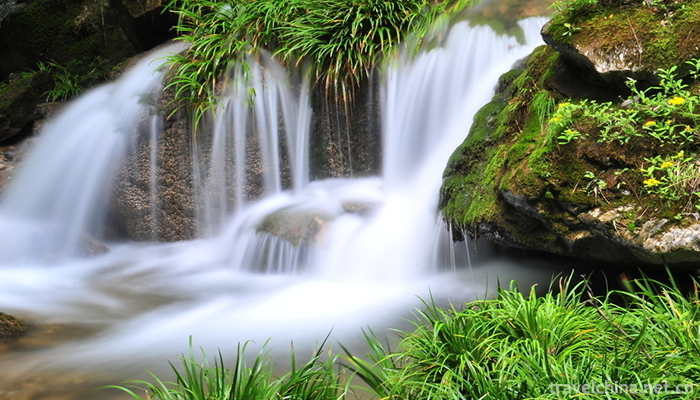

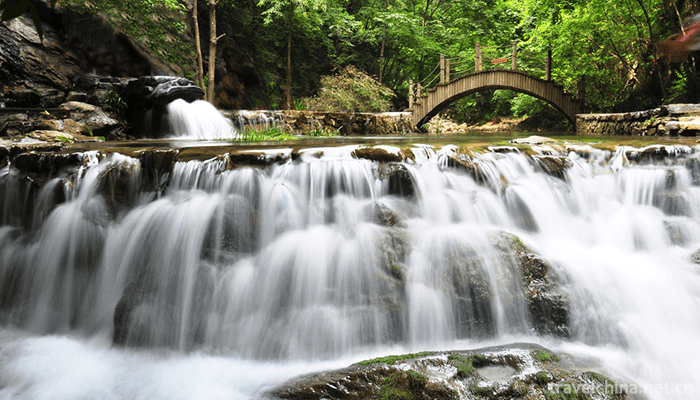
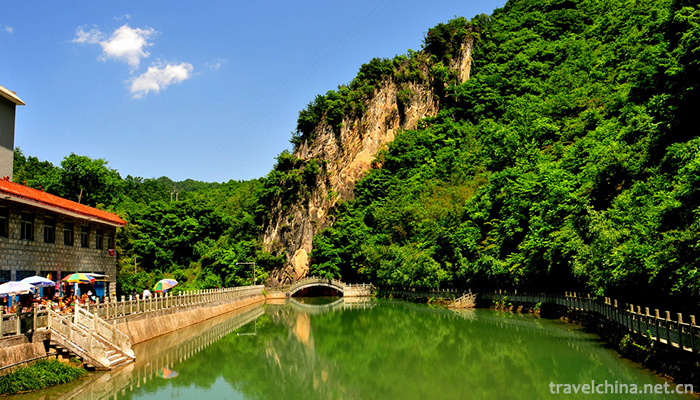
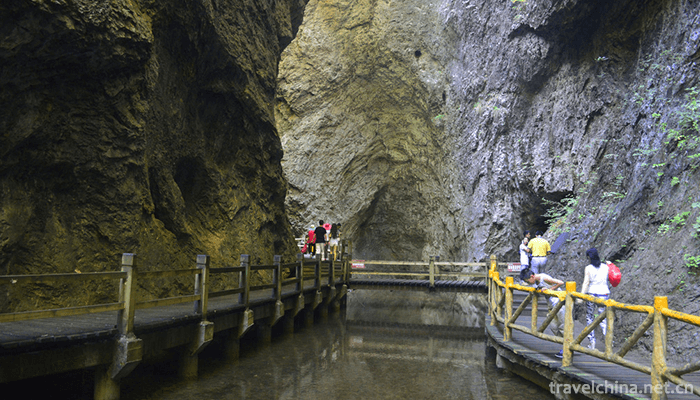
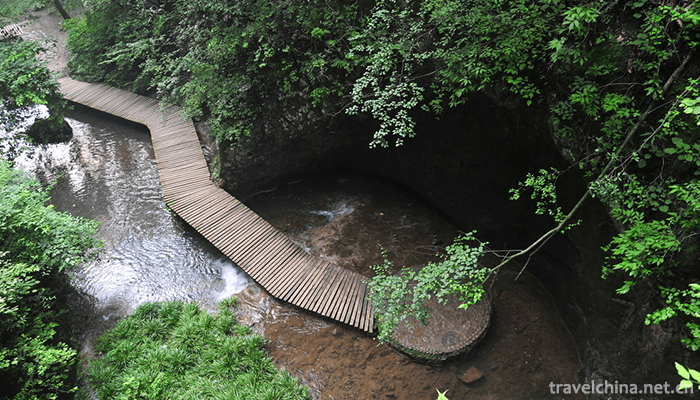
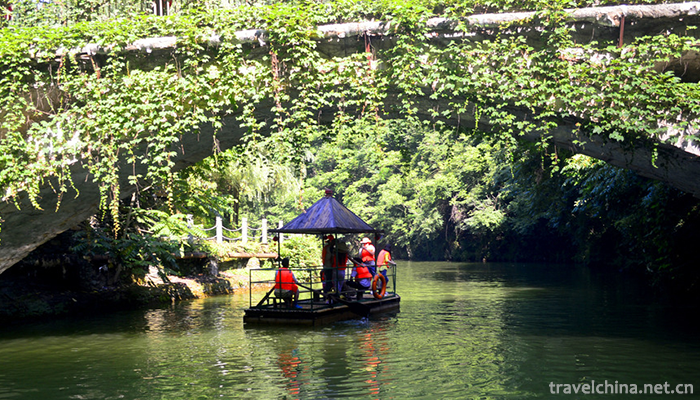
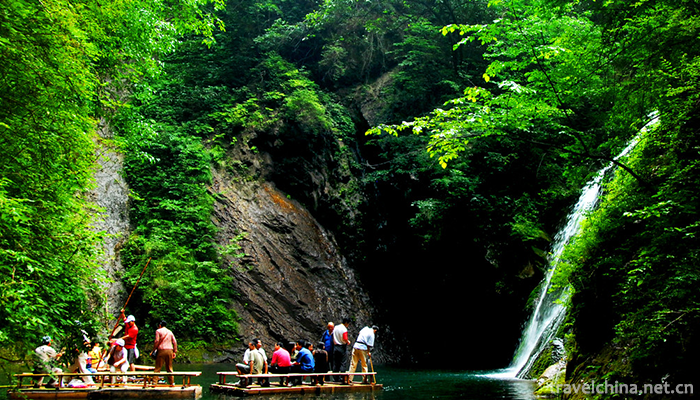
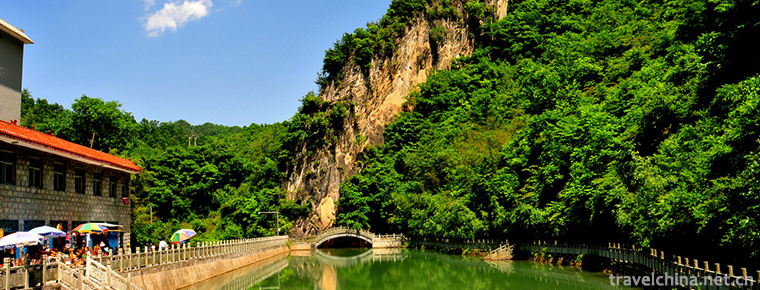
-
1.Dongjiang Lake Tourist Area Coconut City
Dongjiang Lake Scenic Tourist Area is located in Zixing City, Hunan Province. It is a national scenic spot, a national 5A scenic spot and a national wetland park.
Time 2018-12-12 -
2.Chaya Mountain Scenic SpotTime 2019-01-04
-
3.Western Xia imperial tombs
The Mausoleum of the Xixia Dynasty, also known as the mausoleum of the Xixia Emperor and the mausoleum of the Xixia Emperor, is the mausoleum of the successive emperors and the Royal Mausoleum of the
Time 2019-02-25 -
4.Steamed egg with sand
Steamed eggs with ginseng sand is a traditional Chinese medicine, which has the effect of invigorating qi, nourishing blood and soothing the mind.
Time 2019-03-24 -
5.Gong and Drum Art
Gong and drum art can be roughly divided into Yunsheng Gong and drum, Zhongzhou big drum, Ezhou brand gong, Xiaohe Gong and drum, Hanggu flying gong, Changshan battle drum, Taiyuan Gong and drum, Liji
Time 2019-05-15 -
6.Yicheng Qinshu
Yicheng Qinshu is called "Qinshu" because its main accompaniment instrument is Yangqin. Yicheng Qinshu is an ancient traditional folk art. Legend has it that it originated in the late Yuan D
Time 2019-07-13 -
7.Chaohu University
Chaohu College (Chaohu University), located in Chaohu, Hefei, Anhui, Chaohu half soup hot spring health resort, is a Anhui provincial full-time undergraduate institutions, local application oriented i
Time 2019-11-08 -
8.Needlework of Chinese embroidery
Category: random needling, straight needling, disc needling, trowel needling, grabbing needling, flat needling, scattered wrong needling, weaving embroidery, applying needling, auxiliary needling, variant embroidery
Time 2020-12-12 -
9.Chengdu Giant Panda Base tourist service
The tourist center is located 40 meters to the left of the entrance door of the scenic area (first floor of the Giant Panda Museum), with a building area of more than 400 square meters.
Time 2020-12-13 -
10.Nanchong cultural undertakings
By the end of 2019, Nanchong has 10 cultural centers, 242 cultural stations and 10 public libraries. There are 8 museums, 28 cultural relics protection and management institutions, 18 national key cultural relics protection units, 112 provincial-level cultural relics protection units
Time 2020-12-17 -
11.Plant resources in Meishan
There are 2278 species of wild plants belonging to 861 genera and 229 families in Meishan City, including 149 species of bryophytes belonging to 71 genera and 48 families, 155 species of ferns belonging to 73 genera and 36 families, 20 species of gymnosperms
Time 2020-12-18 -
12.Meishan special food
Meishan traditional delicacies and specialties include: sugar and oil fruit, spicy sausage, Sichuan fried spring rolls, Dongpo bean curd elbow, stone bean curd, Dongpo cuttlefish, Dongpo sausage, sweet potato sugar, Meishan Qiao Jiao beef, yameizi so
Time 2020-12-18